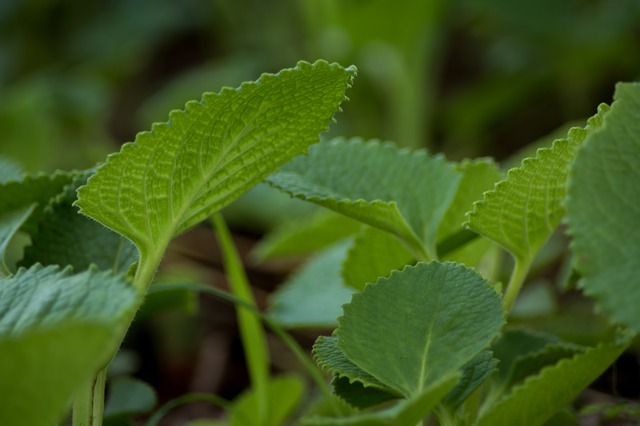Achoo… The word is derived from onomatopoeia — a thing, or action, corresponding to a vocal imitation of the sound associated with it. Add it to, sniffles. And, you hear this, pronto: ‘god bless.’ Three decades down memory lane, like many other kids, I recall my ‘connect’ to the category of ‘runny noses.’
The seasonal effects and allergens triggering a handful of sneezes in me would push my grandmother into her backyard foraging for the perfect ‘cold-kill’ herb. With a hanky tucked onto my frock, along with a safety pin, I’d follow my grandmother, through her evergreen herb-rich yard, holding her herb basket, identifying and smelling all the herbs. Just tasting a few ignited the spirit of the herbalist in me. Her perfect potion for an allergic cold was a blend of juices of the three cardinal herbs mixed with honey. Ginger, tulsi [Holy basil] and this aromatic herb — our ‘guest herb’ of the month — Indian borage.
Grandma’s Recipe
This succulent herb is a species of coleus that goes by the botanical name, Coleus amboinicus, or Plectranthus amboinicus. It is well-known for its benefits in upper respiratory tract infections, gastrointestinal discomfort, skin allergies, intestinal worms, especially in paediatrics. A grandmother’s recipe in home medicine and cookery, the flavour of coleus is all-pervading in the sub-continent. It is easy to maintain. It can be grown in pots and it thrives with just a little hydration.
The herb is called doddapatre, or sambara soppu, or sambrani, in Kannada, karpooravalli, or parnayavani, in Sanskrit, Patta ajwain, or pattarcheer, in Hindi, karpooravalli, in Tamil, panikoorka, in Malayalam, and sugandha vallekam, in Telugu.
The plant, being aromatic, is rich in volatile components. It contains numerous phytochemicals — including monoterepenoids, diterpenoids, triterpenoids, sesquiterpenoids, phenolics, flavonoids and esters. Its two significant phytochemical constituents are thymol and carvacrol. It is also rich in vitamins A and C and omega-6 fatty acids.
The herb is ‘hot’ in nature. It alleviates vata-kapha dosha and aggravates pitta dosha. Ayurvedists prescribe parnayavani for an array of gastrointestinal disorders, including abdominal colic, hepatitis, indigestion, intestinal worms, diarrhoea, respiratory issues, such as allergic rhinitis [hay fever], cold and cough, fevers, sinusitis and skin disorders.
Uses
- Freshly squeezed leaf juice, mixed with honey, is useful in cold and cough
- Leaf juice is administered in intestinal worms
- Leaf juice with salt is given in cases of colic, bloating and dysmenorrhoea [painful periods]
- The plant juice is a good diuretic. It is also useful in renal calculi [kidney stone]
- Leaf paste is used an external application in skin diseases, oedema, and headaches
- Oil cooked with coleus is used as a hair oil to stimulate hair growth and treat dandruff. It also facilitates lactation [NB: Coleus has to be cautiously used in pregnant women].
Borage’s Culinary ‘Barrage’
The aroma and the peppery, pungent taste makes this herb an appetising, stimulating delicacy.
- Chutney. A lip-smacking condiment with roasted coleus leaves, grated coconut, pepper [chillies optional], tamarind and salt, all ground to form a thick paste. It may be seasoned, or unseasoned, and served with hot rice, topped with raw coconut oil and raw onions as accompaniments.
- Tambuli. Prepare, according to the above recipe, and add buttermilk and season it. It is a tasty accompaniment to rice, or may be served as an appetising drink. Raw leaves can also be finely chopped, crushed and added to seasoned buttermilk for a refreshing experience.
- Fritters. A batter of soaked rice, red chillies, ground, and added with salt and chopped coleus leaves, and deep fried. Or, a gram flour/besan-based batter can be an option too. Shallow frying may be followed to minimise oil usage.
Indian borage is one herb with multiple uses — from its therapeutic value for the gut, respiratory, cardiovascular, reproductive and renal systems to a cosmetic embellishment.
You’d, doubtless, always think of it as a universal, more than handy, remedy during the flu season.

